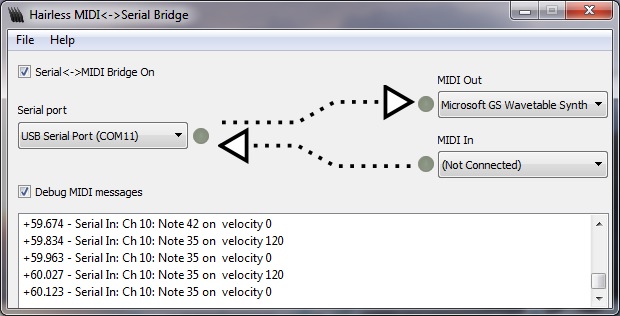Quickstart Midi(out) Keyboard
 laurent974
Posts: 77
laurent974
Posts: 77
Hi,
just a little toy to play with the quickstart pads. Connecting the QS with your PC, you can pilot the GM drums with the pad.
It uses the usb to send Midi message to the PC
How to setup:
on windows:
on the right select microsoft GM / on the left select the USB port where QS is connected

On linux:
How to start:
after downloading to EEPROM, disconnect the QS, then launch your midi software (hairless (with qsynth for linux)) then re-connect your QS.
this is because the midi is sent to port 31,30 the same as the terminal.
to change a bank :
just modify these define
you can find the hexa code here :
jchr.be/linux/midi.htm#batterie
Debug:
at compilation you can put a -D__DEBUG to GCC and see whats going wrong on parallax terminal
Next evolution i suppose that could be fine
propose a bunch of drums set that could be selected at the beginning.
For C coders guru:
i'm sure that code could be optimzed a lot since this is my first time in bits manipulation. If you find better way to do it i would be glad to read your improvments.
just a little toy to play with the quickstart pads. Connecting the QS with your PC, you can pilot the GM drums with the pad.
It uses the usb to send Midi message to the PC
How to setup:
on windows:
install hairless midi projectgus.github.io/hairless-midiserial/
on the right select microsoft GM / on the left select the USB port where QS is connected

On linux:
install hairless midi (ubuntu : sudo apt install hairless)
install sound fount : apt://fluid-soundfont-gm
install a virtual synth : sudo apt install fluidsynth it will install a gui synth called qsynth (launch it from a terminal)

install sound fount : apt://fluid-soundfont-gm
install a virtual synth : sudo apt install fluidsynth it will install a gui synth called qsynth (launch it from a terminal)

How to start:
after downloading to EEPROM, disconnect the QS, then launch your midi software (hairless (with qsynth for linux)) then re-connect your QS.
this is because the midi is sent to port 31,30 the same as the terminal.
to change a bank :
just modify these define
#define BASSDRUM 0x23 #define SNARE 0x26 #define CLAP 0x27 #define TOM1 0x29 #define CLOSEDHH 0x2A #define TOM2 0x2D #define OPENHH 0x2E #define CYMBAL 0x34
you can find the hexa code here :
jchr.be/linux/midi.htm#batterie
Debug:
at compilation you can put a -D__DEBUG to GCC and see whats going wrong on parallax terminal
Next evolution i suppose that could be fine
propose a bunch of drums set that could be selected at the beginning.
For C coders guru:
i'm sure that code could be optimzed a lot since this is my first time in bits manipulation. If you find better way to do it i would be glad to read your improvments.
zip

1012K



Comments
Let me introduce to you the smallest midi keyboard ever : the QSKeyboard.
Now it's possible to select a bank of sound at initialisation. The QS will start blinking red until you touch a pad (one or several). it will then select a bank of sound from midi and you 'll have a tiny midi keyboard at your hand.
For drums => touch the pad P0.
you can modify the scale with theses define
// Notes #define C4_Note 0x3C #define D_Note 0x3E #define E_Note 0x40 #define F_Note 0x41 #define G_Note 0x43 #define A_Note 0x45 #define B_Note 0x47 #define C5_Note 0x48 int chromatic_scale[8] = {C4_Note,D_Note,E_Note,F_Note, G_Note,A_Note,B_Note,C5_Note};